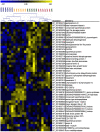Deciphering proteomic signatures of early diapause in Nasonia
- PMID: 19636376
- PMCID: PMC2712079
- DOI: 10.1371/journal.pone.0006394
Deciphering proteomic signatures of early diapause in Nasonia
Abstract
Insect diapause is an alternative life-history strategy used to increase longevity and survival in harsh environmental conditions. Even though some aspects of diapause are well investigated, broader scale studies that elucidate the global metabolic adjustments required for this remarkable trait, are rare. In order to better understand the metabolic changes during early insect diapause, we used a shotgun proteomics approach on early diapausing and non-diapausing larvae of the recently sequenced hymenopteran model organism Nasonia vitripennis. Our results deliver insights into the molecular underpinnings of diapause in Nasonia and corroborate previously reported diapause-associated features for invertebrates, such as a diapause-dependent abundance change for heat shock and storage proteins. Furthermore, we observed a diapause-dependent switch in enzymes involved in glycerol synthesis and a vastly changed capacity for protein synthesis and degradation. The abundance of structural proteins and proteins involved in protein synthesis decreased with increasing diapause duration, while the abundance of proteins likely involved in diapause maintenance (e.g. ferritins) increased. Only few potentially diapause-specific proteins were identified suggesting that diapause in Nasonia relies to a large extent on a modulation of pre-existing pathways. Studying a diapause syndrome on a proteomic level rather than isolated pathways or physiological networks, has proven to be an efficient and successful avenue to understand molecular mechanisms involved in diapause.
Conflict of interest statement
Figures




Similar articles
-
Proteomics of the flesh fly brain reveals an abundance of upregulated heat shock proteins during pupal diapause.J Insect Physiol. 2007 Apr;53(4):385-91. doi: 10.1016/j.jinsphys.2007.01.003. Epub 2007 Feb 1. J Insect Physiol. 2007. PMID: 17349654
-
Shotgun proteomic analysis on the diapause and non-diapause eggs of domesticated silkworm Bombyx mori.PLoS One. 2013 Apr 8;8(4):e60386. doi: 10.1371/journal.pone.0060386. Print 2013. PLoS One. 2013. PMID: 23580252 Free PMC article.
-
When your host shuts down: larval diapause impacts host-microbiome interactions in Nasonia vitripennis.Microbiome. 2021 Apr 9;9(1):85. doi: 10.1186/s40168-021-01037-6. Microbiome. 2021. PMID: 33836829 Free PMC article.
-
Mechanisms of animal diapause: recent developments from nematodes, crustaceans, insects, and fish.Am J Physiol Regul Integr Comp Physiol. 2016 Jun 1;310(11):R1193-211. doi: 10.1152/ajpregu.00250.2015. Epub 2016 Apr 6. Am J Physiol Regul Integr Comp Physiol. 2016. PMID: 27053646 Free PMC article. Review.
-
[Physiological and molecular biological mechanisms underlying diapause in aquatic invertebrates].Ontogenez. 2010 Mar-Apr;41(2):83-93. Ontogenez. 2010. PMID: 20429368 Review. Russian.
Cited by
-
Characterization and Developmental Expression Patterns of Four Hexamerin Genes in the Bumble Bee, Bombus terrestris (Hymenoptera: Apidae).J Insect Sci. 2021 Sep 1;21(5):13. doi: 10.1093/jisesa/ieab078. J Insect Sci. 2021. PMID: 34636890 Free PMC article.
-
Proteomic and metabolomic profiles of larval hemolymph associated with diapause in the cotton bollworm, Helicoverpa armigera.BMC Genomics. 2013 Nov 1;14(1):751. doi: 10.1186/1471-2164-14-751. BMC Genomics. 2013. PMID: 24180224 Free PMC article.
-
Dormancy in Embryos: Insight from Hydrated Encysted Embryos of an Aquatic Invertebrate.Mol Cell Proteomics. 2017 Oct;16(10):1746-1769. doi: 10.1074/mcp.RA117.000109. Epub 2017 Jul 20. Mol Cell Proteomics. 2017. PMID: 28729386 Free PMC article.
-
Differential gene expression and protein abundance evince ontogenetic bias toward castes in a primitively eusocial wasp.PLoS One. 2010 May 17;5(5):e10674. doi: 10.1371/journal.pone.0010674. PLoS One. 2010. PMID: 20498859 Free PMC article.
-
Development of a Nasonia vitripennis outbred laboratory population for genetic analysis.Mol Ecol Resour. 2014 May;14(3):578-87. doi: 10.1111/1755-0998.12201. Epub 2013 Dec 12. Mol Ecol Resour. 2014. PMID: 24215457 Free PMC article.
References
-
- Harvey WR. Metabolic aspects of insect diapause. Annual Review of Entomology. 1962;7:57–&.
-
- Tauber MJ, Tauber CA, Masaki S. Oxford University Press; 1986. Seasonal adaptations of insects.411
-
- Denlinger DL. Regulation of diapause. Annu Rev Entomol. 2002;47:93–122. - PubMed
-
- Tatar M, Yin C. Slow aging during insect reproductive diapause: Why butterflies, grasshoppers and flies are like worms. Exp Gerontol. 2001;36:723–738. - PubMed
Publication types
MeSH terms
Substances
Grants and funding
LinkOut - more resources
Full Text Sources

